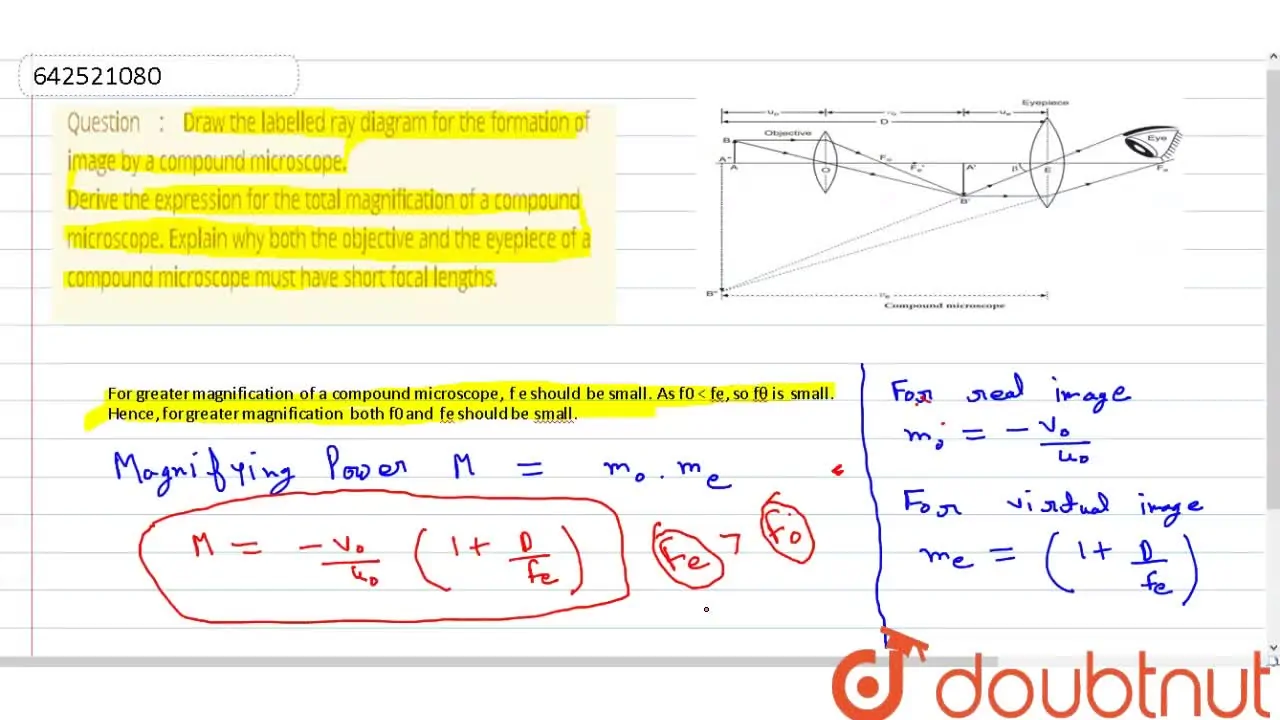Draw the labelled ray diagram for the formation of image by a compound microscope.
Derive the expression for the total magnification of a compound microscope. Explain why both the objective and the eyepiece of a compound microscope must have short focal lengths.
(a) Image formation by a compound microscope : A schematic diagram of a compound microscope is shown in Fig.

(b) Magnifying Power : The linear magnification due to the objective is
..(i)
Also
...(ii)
From (i) and (ii), we have
..(iii)
When h' is the size of the first image, the object size being h and being the focal length of the objective and L be the distance between the second focal point of the objective and first focal point of the eye piece (focal length ) is called the tube length of compound microscope.
When the final image is formed at the near point, then the angular magnification of the eye piece is
...(iv)
Total magnification of compound microscope is
[ From (iii) and (iv)]
When the final image is formaed at infinity then,
(c) For large magnifying power both have to be small. Also is taken to be smalller than so that the field of view may be increased.
Related Playlists
- BOOK - XII BOARD PREVIOUS YEAR PAPER ENGLISHCHAPTER - XII BOARDSEXERCISE - SET II8videos
XII BOARDS
- BOOK - XII BOARD PREVIOUS YEAR PAPER ENGLISHCHAPTER - XII BOARDSEXERCISE - SET III7videos
XII BOARDS
- BOOK - XII BOARD PREVIOUS YEAR PAPER ENGLISHCHAPTER - XII BOARDSEXERCISE - SECTION - B7videos
XII BOARDS
- BOOK - XII BOARD PREVIOUS YEAR PAPER ENGLISHCHAPTER - SAMPLE PAPER 2019EXERCISE - SECTION D6videos
SAMPLE PAPER 2019
Similar Questions
Magnification of compound microscope is not connected with
View Solution(i) Draw a neat labelled ray diagram of a compound microscope . Explain briefly its working .
(ii) Why must both the objective and the eye-piece of a compound microscope have short focal lengths ?View SolutionThe focal length of the objective lens of a compound microscope is
View SolutionDefine the magnifying power of a compound microscope when the final image is formed at infinity. Why must both the objective and the eyepiece of a compound microscope have short focal lengths ? Explain.
View Solution(a) Draw a ray diagram showing the image formation by a compound microscope. Hence obtain expression for total magnification when the image is formed at infinity.
View Solution(a) Draw a labelled ray diagram showing the formation of a final image by a compound microscope at least distance of distinct vision.
(b) The total magnification produced by a compound microscope is 20. The magnification produced by the piece is 5. The microscope is focused on a certain object. The distance between the objective and eyepiece is observed to be 14cm. If least distance of distinct vision is 20cm, calculate the focal length of the objective and the eye piece.View SolutionThe image formed by an objective of a compound microscope is
View SolutionThe image formed by an objective of a compound microscope is
View SolutionDraw a labelled diagram of an image formed by a compound microscope with image at least distance of distinct vision.
View SolutionDraw a schematic ray diagram of a compound microscope with the final image formed at infinity.
View Solution


